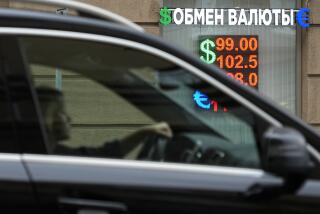German Central Bank Slashes Key Rates : Credit: Half-point cut could boost flagging European economy. Meanwhile, U.S. bond yields fall on new report.
- Share via
FRANKFURT — The German Bundesbank slashed short-term interest rates Thursday to their lowest level since December, 1988, in a move that could re-energize Europe’s economy and help strengthen the rebounding U.S. dollar.
In the United States, meanwhile, a weaker-than-expected report on July durable-goods orders drove short- and long-term bond yields sharply lower on hopes that the Federal Reserve Board may also still have room to reduce rates.
And in Japan, government officials said they will soon announce a fresh economic stimulus plan that will involve $104 billion in additional government spending to stoke business activity.
The renewed focus on boosting growth within the world’s three leading economies is likely to have implications for the global economy as a whole, experts noted.
Indeed, the Bundesbank’s rate cut was immediately followed by similar cuts in Austria, Denmark, Belgium and the Netherlands. As the largest economy in Europe, Germany has for decades dictated rates for the entire Continent.
The German central bank cut its discount rate, the base short-term German rate, to 3.5% from 4%. It also reduced its Lombard rate, used to peg emergency interbank loans, to 5.5% from 6%.
The Bundesbank gave no extended explanation of its move, saying only that recent low growth in Germany’s money supply had been “the decisive reason” for cutting rates. Many economists believe that the pace at which money is created directly influences inflation, which is considered public enemy No. 1 by the Bundesbank.
Expectations that the Bundesbank would lower rates began to mount Tuesday when the bank’s president, Hans Tietmeyer, suggested in an interview that statistics on the money supply and on inflation were “moving in the right direction” for lowering rates.
Economists said low money-supply growth, combined with recent favorable inflation numbers from three German states, delivered the Bundesbank the perfect opportunity for a rate cut--which some German politicians, businesses and economists have long argued was needed to give the sluggish German economy a kick.
“The cut fit perfectly with the economic situation,” said Hermann Remsperger, chief economist at BHF Bank in Frankfurt.
German Finance Minister Theo Waigel welcomed the rate cuts, saying they would improve prospects for inflation-free growth.
Lower German rates also could further weaken the German mark, helping the country’s exporters. However, on Thursday the mark strengthened--and the dollar fell--as traders took profits from the dollar’s recent advance.
The dollar fell to 1.474 marks in New York from 1.483 on Wednesday. It also eased to 96.53 Japanese yen from 96.60.
The dollar also may have been hurt by the U.S. report that durable-goods orders fell 1.7% in July, a bigger-than-expected decline that raised questions as to whether the American economy is pulling out of its spring doldrums.
On the positive side, U.S. bond yields tumbled Thursday in the wake of the durable-goods report, as investors focused on the potential for the Fed to follow the Bundesbank and reduce U.S. short-term rates this fall if the economy fails to show solid growth soon.
The Fed met earlier this week and left short-term rates unchanged, but many economists believe it will lower rates before November. The Fed cut short rates by a quarter of a point in early July.
On Thursday, the yield on the benchmark 30-year Treasury bond fell to 6.81% from 6.91%, reaching its lowest level since July 18. Shorter-term bond yields also fell, with the six-month T-bill yield dropping to 5.60% from 5.69%.
More to Read
Inside the business of entertainment
The Wide Shot brings you news, analysis and insights on everything from streaming wars to production — and what it all means for the future.
You may occasionally receive promotional content from the Los Angeles Times.










